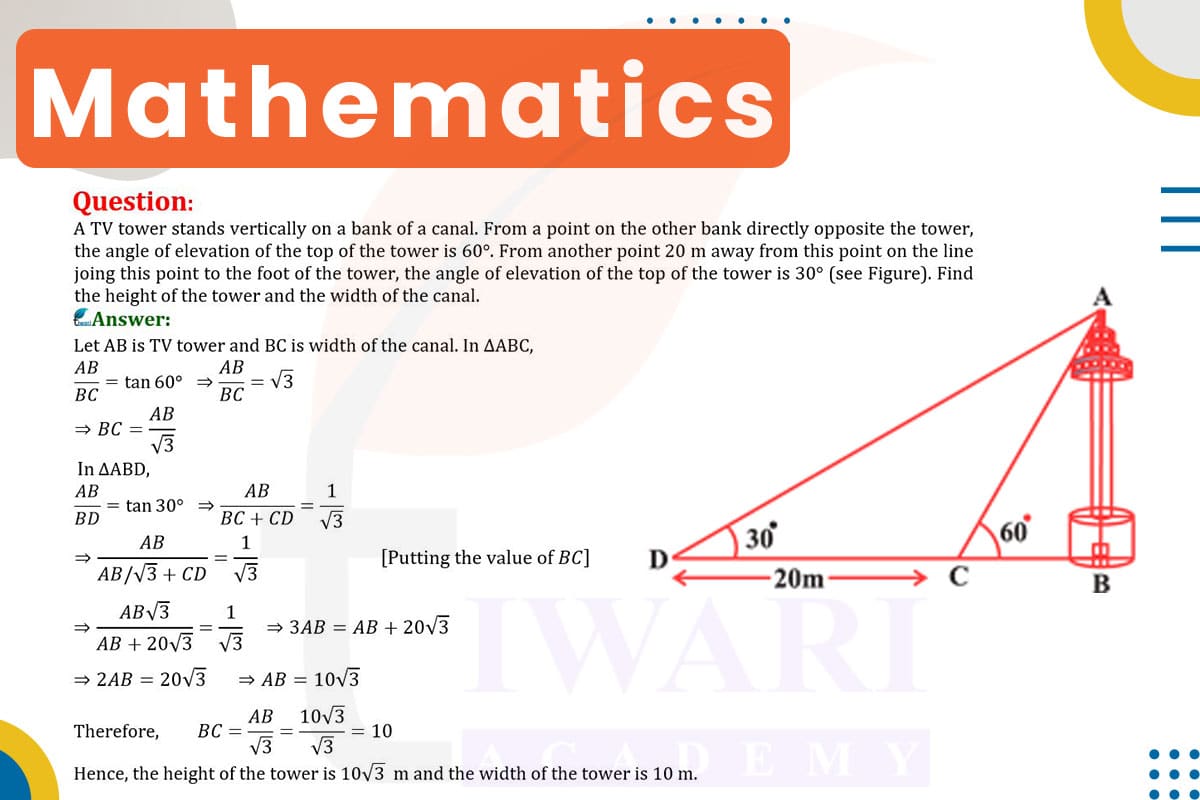To find the height of the TV tower and the width of the canal, we use trigonometry. Let’s denote the height of the tower as h and the width of the canal as d.
From the Point Directly Opposite (60° Angle of Elevation): Using tan(60°) = √3, the equation is √3 = h/d.
From the Point 20 m Away (30° Angle of Elevation): The distance from this point to the tower’s foot is d + 20 m. Using tan(30°) = 1/√3, the equation is 1/√3 = h/(d+20).
Solving these equations simultaneously, we find h = 20√3 m (approximately 34.64 m) and d = 20 m. Therefore, the height of the tower is about 34.64 meters, and the width of the canal is 20 meters.

Let’s discuss in detail
Trigonometric Applications in Geometric Measurement
Trigonometry, a vital branch of mathematics, is extensively used in geometric measurement, particularly in determining the dimensions of structures and distances in scenarios where direct measurement is not feasible. The problem at hand involves a TV tower standing on the bank of a canal and requires determining the tower’s height and the canal’s width. This is achieved by analyzing the angles of elevation from two different points on the opposite bank. This scenario exemplifies the practical application of trigonometry in real-world situations, demonstrating its importance in fields like engineering, surveying, and architecture.
Understanding the Problem: TV Tower and Canal
The problem presents a TV tower standing vertically on one bank of a canal. From a point directly opposite the tower on the other bank, the angle of elevation to the top of the tower is 60°. From another point 20 meters away from the first, along the line joining this point to the foot of the tower, the angle of elevation is 30°. The objective is to determine the height of the tower and the width of the canal, forming two distinct right-angled triangles with the tower.
The Role of Tangent in Angle of Elevation
In trigonometry, the tangent of an angle in a right-angled triangle is the ratio of the length of the opposite side (height of the tower) to the length of the adjacent side (horizontal distance from the point to the tower). By applying the tangent function to the given angles of elevation, we can calculate the height of the tower and the width of the canal.
Calculating the Width of the Canal
First, we use the tangent function for the 60° angle of elevation from the point directly opposite the tower. The equation is tan(60°) = √3 = h/d, where d is the width of the canal. This equation will be used in conjunction with the second angle of elevation to solve for h and d.
Determining the Height of the Tower
Next, we apply the tangent function to the 30° angle of elevation from the point 20 meters away. The equation is tan(30°) = 1/√ = h/(d+20). This equation, combined with the first, allows us to solve for the height of the tower and the width of the canal simultaneously.
Trigonometry in Practical Measurement
Solving the equations √3 = h/d and 1/√3 = h/(d+20)simultaneously, we find that the height of the tower is approximately 34.64 meters, and the width of the canal is 20 meters. This example illustrates the practical application of trigonometry in determining dimensions and distances in real-life scenarios. Trigonometry proves to be an invaluable tool in various fields, offering a mathematical approach to solving problems where direct measurement is challenging or impossible.
Discuss this question in detail or visit to Class 10 Maths Chapter 9 for all questions.
Questions of 10th Maths Exercise 9.1 in Detail

